#deodar trees
Text
Bakrota Hills, Dalhousie: Embracing the Tranquil Beauty of the Himalayas
Nestled in the heart of Dalhousie, Himachal Pradesh, the enchanting Bakrota Hills stands as a testament to the unparalleled beauty that the Himalayas have to offer. Situated just 5 km away from Dalhousie at an elevation of 2085 meters above sea level, Bakrota Hills captivates the hearts of all who venture into its serene landscapes. This picturesque destination, surrounded by majestic snow-clad…

View On WordPress
0 notes
Text
Exploring the Untouched Beauty of Barot Valley in Mandi, Himachal Pradesh | #travel #shortsvideo
Barot Valley is a beautiful and less-explored destination located in the Mandi district of Himachal Pradesh, India. Barot is known for its picturesque landscapes, lush greenery, and serene surroundings. Location: Barot is situated in the Mandi district of Himachal Pradesh, India, and is approximately 67 kilometers away from Mandi town. Scenic Beauty: The valley is surrounded by dense forests, deodar trees, and mountains, making it a perfect destination for nature lovers. The Uhl River flows through the valley, adding to its charm. Trout Fishing: The Uhl River is famous for trout fishing, and the Fisheries Department has a trout breeding center in Barot. Fishing enthusiasts often visit the area for angling. Treks and Hikes: Barot offers various trekking and hiking opportunities. The trek to Bada Bhangal, which is one of the remotest villages in Himachal Pradesh, starts from Barot. Nargu Wildlife Sanctuary: The Nargu Wildlife Sanctuary is nearby, providing opportunities for wildlife enthusiasts and nature photographers. Paragliding: Adventure enthusiasts can also enjoy paragliding in the region, offering breathtaking aerial views of the valley. Camping: Barot is relatively less crowded compared to some other tourist destinations in Himachal Pradesh, making it an ideal place for camping and experiencing the tranquility of nature. Accessibility: The road to Barot can be a bit challenging, but the journey itself is scenic. It's advisable to check the current road conditions before planning a trip. Explore the stunning landscapes of Himachal Pradesh with Jannat Travel Guru Tour and Travel Agency! We specialize in crafting unforgettable Himachal tour packages and providing valuable information about the must-visit tourist destinations in this Himalayan paradise.
#Barot Valley#Mandi#Himachal Pradesh#Uhl River#Trout Fishing#Nargu Wildlife Sanctuary#Trekking#Hiking#Bada Bhangal#Paragliding#Camping#Scenic Landscapes#Deodar Trees#Nature Exploration#Remote Village#Adventure Tourism#Serene Surroundings#Nature Photography#Tranquil Retreat#Offbeat Destination
0 notes
Text

Christmas Tree Lane is a 0.7-mile boulevard of deodar cedar trees in Altadena, California. The trees on the Lane, Santa Rosa Avenue, have been lighted annually as a Christmas Holiday display since 1920. The association that runs it claims it is "the oldest large-scale outdoor Christmas display in the world.” Christmas Tree Lane was listed on the U.S. National Register of Historic Places in 1990, the same year it was also designated as California Historical Landmark No. 990. 🎄
#Christmas Tree Lane#boulevard#deodar cedar trees#Altadena#California#Santa Rosa Avenue#1920#vintage Christmas#Christmas holiday#christmas display#California Historical Landmark No. 990#Winter Wonderland#winter photography
10 notes
·
View notes
Text

Present.
India 2023.
#travel#photography#india#backpacking#nature#mountains#himalayas#trees#fields#home#belonging#land#wheat#rice#landscape#relaxing#solitude#deodar#pine#forests#life#contemplate#consider
3 notes
·
View notes
Note
2, 23, and 40?
Describe your favorite pair of socks
These socks that I knit myself!
They were fun to knit, the yarn is really nice and also sturdy, and they're incredibly comfortable.
Second runner up is a pair of socks I bought in the gift shop at the Metropolitan Museum of Art with tiny astronauts and the moon on them.
Which songs do you like to sing in the shower?
I'm not actually much of a shower singer unless I have my speaker on in the bathroom, and then it's whatever I happen to be listening to at the time. I will say that the most recent Florence + the Machine is good shower singing, as is Get Lonely, both for that full body emotional experience.
What’s your favorite kind of tree?
I love trees SO MUCH, like all kinds of trees - in my neighborhood, my favorite is the dogwood. The flowers are so pretty and very important personally, and then they're gorgeous all leafed out, too. My favorite out in the woods tree is probably vine maple, a regional icon. And then my favorite tree from my childhood is the deodar cedar, instant nostalgia.
[50 questions just because]
#favorite socks is actually a really hard question!#I have about 2 dozen? pairs that I've knit myself and I really like most of them#knitting my own socks was one of those odd little life changing things#also: I love every tree in my neighborhood#there's something interesting and beautiful about every single one#there is actually a deodar in my current neighborhood#which makes me very happy
1 note
·
View note
Text
Planting trees does not necessarily mean a forest is being restored.
---
But efforts to increase global tree cover to limit climate change have skewed towards erecting plantations of fast-growing trees. The reasons are obvious: planting trees can demonstrate results a lot quicker than natural forest restoration. This is helpful if the objective is generating a lot of timber quickly or certifying carbon credits which people and firms buy to supposedly offset their emissions. [...] [I]ll-advised tree planting can unleash invasive species [...]. For more than 200 years India has experimented with tree plantations, offering important lessons about the consequences different approaches to restoring forests have on local communities and the wider environment. This rare long-term perspective should be heeded [...].
Britain extended its influence over India and controlled much of its affairs [...] from the mid-18th century onwards. Between 1857 and 1947, the Crown ruled the country directly and turned its attention to the country’s forests. Britain needed great quantities of timber to lay railway sleepers and build ships in order to transport the cotton, rubber and tea it took from India.
Through the Indian Forest Act of 1865, forests with high-yielding timber trees such as teak, sal and deodar became state property. To maximise how much timber these forests yielded, British colonial authorities restricted the rights of local people to harvest much beyond grass and bamboo. [...] Meanwhile plantations of teak (Tectona grandis), a species well adapted to India’s hot and humid climate and a source of durable and attractive timber, spread aggressively. [...]
---
[G]rasslands and open scrub forest gave way to teak monocultures.
Eucalyptus and other exotic trees which hadn’t evolved in India were introduced from around 1790. British foresters planted pines from Europe and North America in extensive plantations in the Himalayan region as a source of resin and introduced acacia trees from Australia for timber, fodder and fuel.
One of these species, wattle (Acacia mearnsii), first introduced in 1861 with a few hundred thousand saplings, was planted in the Nilgiris district of the Western Ghats. This area is what scientists all a biodiversity hotspot – a globally rare ecosystem replete with species. Wattle has since become invasive and taken over much of the region’s mountainous grasslands.
Similarly, pine has spread over much of the Himalayas and displaced native oak trees while teak has replaced sal, a native hardwood, in central India. Both oak and sal are valued for fuel, fodder, fertiliser, medicine and oil. Their loss [...] impoverished many.
---
India’s national forest policy [...] aims for trees on 33% of the country’s area. Schemes under this policy include plantations consisting of a single species such as eucalyptus or bamboo which grow fast and can increase tree cover quickly, demonstrating success according to this dubious measure. Sometimes these trees are planted in grasslands and other ecosystems where tree cover is naturally low. The result is that afforestation harms rural and indigenous people who depend on these ecosystems [...].
In the Kachchh grasslands of western India communities were able to restore grasslands by removing the invasive gando bawal (meaning “mad tree”) first introduced by British foresters in the late 19th century. [...]
The success of forest restoration efforts cannot be measured by tree cover alone. The Indian government’s definition of “forest” still encompasses plantations of a single tree species, orchards and even bamboo, which actually belongs to the grass family. This means that biennial forest surveys cannot quantify how much natural forest has been restored, or convey the consequences of displacing native trees with competitive plantation species or identify if these exotic trees have invaded natural grasslands which have then been falsely recorded as restored forests. [...]
Planting trees does not necessarily mean a forest is being restored. And reviving ecosystems in which trees are scarce is important too.
---
Text by: Dhanapal Govindarajulu. "India was a tree planting laboratory for 200 years - here are the results." The Conversation. 10 August 2023. [Bold emphasis, some paragraph breaks/contractions, and italicized first line in this post added by me.]
141 notes
·
View notes
Text

Developing cones on a weeping deodar cedar tree (Cedrus deodara Pendula)
30 notes
·
View notes
Text
HIDIMBI DEVI TEMPLE

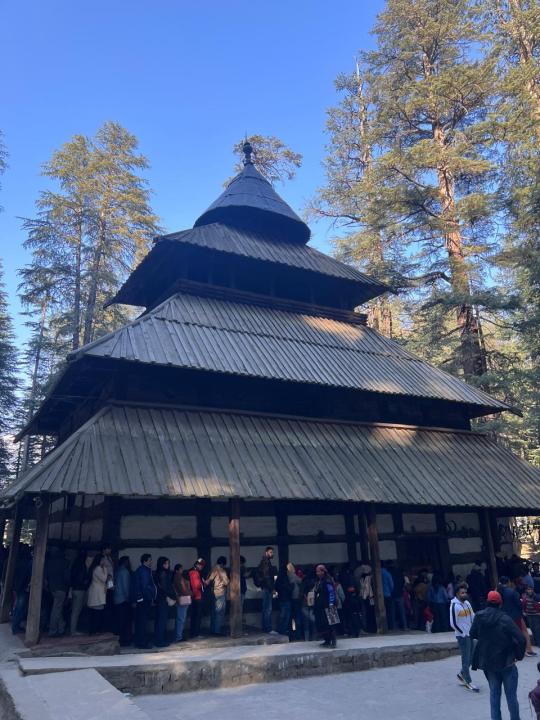
Manali, a popular destination in Himachal Pradesh, is home to the Hidimbi Devi Temple, also known as the Hadimba Temple. Situated in Manali village, around two kilometres from the town, this temple is famous for the Phaghi fair held in honour of Manu Maharaj on the sixth day of Phalgun.
The temple, an ancient cave dedicated to Hidimbi Devi, is surrounded by lush greenery and Deodar trees, creating a serene atmosphere. Legend has it that during the Pandavas' exile, Bhima, one of the brothers, fell in love with Hidimbi, the sister of the local ruler, Hadimb. Bhima defeated Hadimb, married Hidimbi, and they had a son named Ghatotkacha. When the Pandavas returned from exile, Hidimbi stayed behind to meditate and eventually became a goddess, with the cave as her sacred abode.
The temple, known as Dhoongri temple due to its location in the Dhungiri Van Vihar forest, is a beautiful wooden structure with thatched roofs. While it's only 1.5 kilometres from the town, visiting early in the morning is advisable, especially during the busy summer season when Manali is often congested with traffic.
📍 LOCATION:Regency Road, Siyal Rd, Siyal, Manali, Himachal Pradesh
5 notes
·
View notes
Text

The cedar tree has been revered for its spiritual significance for thousands of years and it is the main ingredient of temple incense used by the Tibetan Buddhists. It is clearing, grounding and fortifying. In the Himalayas, cedar is called “deodar” from the Sanskrit word “devdar,” meaning timber of the gods.
Cedarwood essential oil improves cerebral activity, relaxes the body, enhances concentration, reduces anxiety and stress, eases tension, clears the mind, and encourages quality sleep.
7 notes
·
View notes
Text
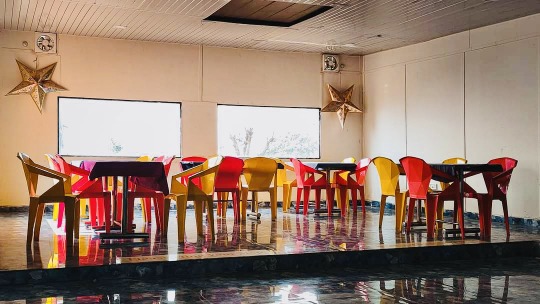


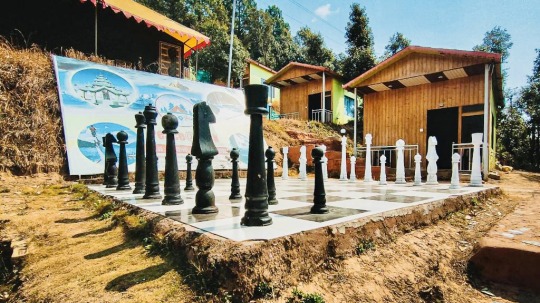








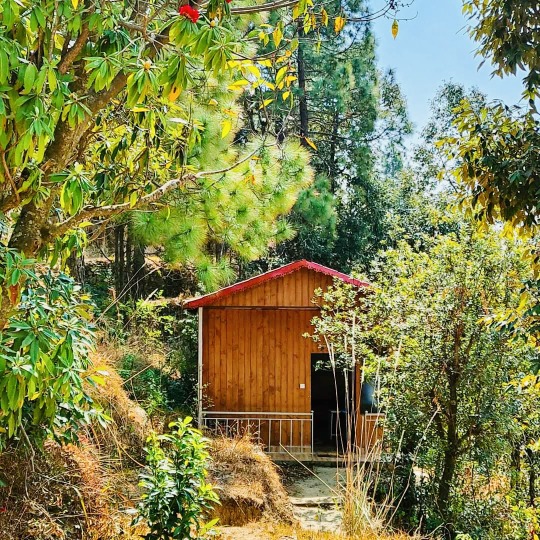
Best Resort Kanatal uttarakhand near dhanaulti
CALL US FOR BOOKING 9891532947
#KANATALCROWN #RESORTINKANATAL #DHANAULTI #UTTARAKHAND #TRIPTOKANATAL
ABOUT KANATAL
Hotel Kanatal Crown, a nature resort that is a precious jewel in the crown of Uttarakhand gives you a remarkable, alluring and bracing holiday experience. Set amidst majestic forests of pine, deodar trees, magnificent rhododendrons, fruit-bearing apple trees, terrace farms intricately carved along hillsides, Water Fall chirping birds all around and the fresh, invigorating mountain air, the impeccable lodging, travel, Wellness, adventure, conference, dining, and entertainment facilities at Hotel Kanatal Crown blend beautifully with nature's bounty.
Hotel Kanatal Crown is framed in a five acre plot with a view of snow-clad Himalayan peaks. Hotel Chakrata Homes offers 10 rooms and a suite with the excellent facilities which have been designed with careful thought to the most minute details and painstaking efforts, all aimed at enhancing the comfort and well being of our esteemed guests.
Hotel Kanatal Crown is one of Delhi’s nearest snow destination, occupying prime location on the Mussoorie Chamba highway, the high point of the year at Dhanaulti occurs between December and February, when over 50 inches of powder snow carpets its areas, creating a spectacular Cottonwood Canyon and transforms the landscape into a ravishing white wonderland. It’s a paradise where you can put your feet up, pamper your frayed nerves and take in deep breaths of the Frangipani-scented breeze that wafts across the resort. Best Resort In Kanatal, Hotels in Kanatal Crown
#uttarakhand#india#pahadi#uttarakhandheaven#travel#dehradun#himalayas#nature#uttarakhandtourism#mountains#incredibleindia#photography#rishikesh#travelphotography#himachal#uttrakhand#uttarakhanddiaries#kedarnath#uttarakhandtraveller#devbhoomi#instagram#nainital#love#garhwal#almora#uttarakhandi#diaries#travelgram#delhi#pithoragarh
4 notes
·
View notes
Text
Jana Waterfalls | Manali Himachal Pradesh
Jana Waterfalls | Manali Himachal Pradesh
One of the most alluring destinations in the picturesque community known as Jana is a waterfall known as Jana Waterfall. In the Himalayan region of Manali, you’ll find this settlement just a few kilometres away from Naggar. The breathtaking natural splendour of this waterfall allows each traveller to experience it in a way that they never had before.
The water cascades down from a certain…

View On WordPress
#Apple Orchards#deodar trees#jana village#jana waterfall#kullu#Manali#naggar village#pine forests#snow-capped mountains
0 notes
Text

@abyssmalice ➤ unprompted
(a story for the god of hugs? very well, tol toni will do her best - !)
“Let’s see.” She hums, her one eye closing in thought for a moment. “How about... yes. Shall I tell you the story of the king and the deodar god? Once upon a time, in an era that was and wasn’t, there was a king who lived in a land of great verdure and wisdom.
“One day, this king wished to repair his palace. However, rather than mere maintenance, he resolved to rebuild it better and grander. Thus, he ordered his advisors to seek a type of tree that would satisfy his great requirements. These advisors searched high and low, scattering themselves across the distant boundaries of the land, and brought many a kind of tree to the king’s attention.
“However, despite this, despite the vast forests and splendid greenery surrounding his kingdom to the horizon and beyond - the king could not be satisfied. Not until one maidservant, from a distant village, made mention of a great tree that her hometown worshipped.
‘”It is a tree that has stood tall and beautiful for generations upon generations,’ so said the maidservant in passing, ‘thus do we worship it, for no doubt, it bears the wisdom of a god within it.’
“Piqued by this, the king thus set forth to the servant’s village. There, he beheld a most magnificent tree - a deodar of great age, standing far above even the tallest house in the village. Its branches numbered in the thousands, and upon the boughs, its dark pines stretched out into a gentle canopy. The king was enthralled by such a wonderful tree. And so, he demanded to have it cut down for his palace.
“The villagers protested, of course. For it was an ancient tree, their divine protector and patron - how could they allow it to be cut down? The king could argue his point as much as he wished, but they would not acquiesce to such an order, even from their sovereign.
“This continued for many a day, with a simmering bitterness as negotiations continued to fail. After one such failure, the frustrated king retired for the day, deciding he shall ruminate on his options and find another way to persuade them. It was that night, as he dreamt, that the divinity of the deodar spoke to him -
‘”O’ ye lord, child of man and knowledge. I do not berate your ambition, for humanity is fated to surpass the gods themselves. However, know this - an ambition is a spark to a fire, and all fires require timber. O’ ye lord, child of man and knowledge but not wisdom—do you wish for your home and all within to burn?’
“Awakening from this dream, the king was certainly frightened. And yet, as he allowed the god’s words to settle, he was humbled by the wise words of the divine tree. Thus, he returned to the village and declared that he would no longer seek the wood of the divine deodar, apologizing for wasting his people’s time in such a frivolous manner.
“He returned to the capitol, and decided instead to rebuild his palace with stone instead of wood, refocusing on his duties as a wise king.” Tonia claps her hand. “And his reign was considered a golden age for that era. The end.”

Eyebrows raised a little as Tonia began recalling a story that they had so explicitly asked for, chin coming to rest in their palm and eyes half-lidded as they so quietly listened without a peep or chime.
They’d be lying if they didn’t say that something resonated deep within them ... memories of the past, of verdant forests, of people who thought themselves above the eyes of the gods ... people had very much tried the same with the hybrid Irminsul that one decorated the Sumerian lands. For research, for some superstition, for its properties ... those humble would receive, those with an ambition to spark a flame, well ... a 13-foot talking deer does often dissuade most people from going through with that blaze.
It took them a little while before they spoke again, starting off with a low rumble and settling into a fond sigh. “I almost feel like this was targeted to me ... a wise deity in a tree? Having to keep outside humans away from taking too much? ... hopefully he didn’t come across a talking stone as well that was worshipped.”

Terrible joke, but they couldn’t help but to heartily cackle for a moment—hard not to when being a creature of the elements and knowing that everything could have a life tied to it. Their laughter eventually died down into another content sigh, straightening up from their rested position.
“... a good story to be passed down, that is for sure. Perhaps I will tuck that into my memory as a little story to share with others as well, even if only by mouth.” Even if it was never to exist in written word ... even one person recalling it will bring it back to life, once more.
#[ sylvie vc: i came out to have a good time and i did but also was attacked ]#SYLVIE // ANSWERED.#OOC // WAITING FOR QUEUE.#abyssmalice
3 notes
·
View notes
Text
An awakening at Manali.

Travelling is one of the best things I have inherited from my family. In the wake of difficult situations, they don’t fail to travel. They believe life is too short and we must travel instead of cribbing about it.
I have travelled a lot of solo trips that usually ranged from 4 to 5 days. Pretty long ones!
The trip to Manali was one of the most important trips of my life. For me, it was a spiritual journey as I was trying to overcome a traumatic life experience of losing someone dear to me. Every trip is life-defining, and on this trip, I learnt one of the most important lessons— “One must keep going in life despite the hurdle. Explore the talents and side hustles. Do not stop. No. Don’t. It will just add a pause to the practice. “
When I reached Manali, the view was so extraordinary. The snow-capped Himalayan peaks and forests full of deodar, pine and rhododendron trees were grabbing my attention, and on another side, the pain of loss was caving me.
It was a four-day trip. For the first two days, I stayed in a hotel room. But on the third day, my room service recommended I visit one shop downstairs as they prepare yummy ‘parathas’. I was reluctant to go, and in my monologue, I asked myself, “What is stopping you?” There was no answer. I just sat for another 3 hours when my stomach grumbled loudly. I called the housekeeping service, and they informed me that the staff couldn’t come because he was stuck in traffic. I was in dire need of food, so I went downstairs and tried the parathas at the recommended shop.
Yes, it was tasty! While I munched the parathas, I noticed the scene outside and saw the beautiful Beas river flowing next to the shop. I was so inspired that I immediately took my phone and clicked the scenery. The food was delicious, so I thanked the paratha wala and went to my room. While looking at the photo, I realised being in a beautiful place, I must leave my sorrows behind and live this moment and explore the area.
So, there was no stopping. I visited Solang Valley, Himalaya Niyamgmapa Buddhist Temple and The Manali Castle.
Some photos of the trip are here.
You can see my other photography work here.
Though at times, a question often arises in my mind, why will someone read my story? Well, I never got an answer because writing is my quest. I feel that the audience at large can connect with me. So, this post is my personal experience. Maybe my story inspires you to feel different.
3 notes
·
View notes
Text
Devidarh: A hidden treasure of Himachal
Sceneric beauty of this hidden place is not less than Kashmir

Akhilesh Mahajan,Mandi
Surrounded by the captivating view of lush green cedars in the lap of nature, the beauty of Devidarh is enchanting. Nature has tried to fill all the colors that comfort the soul here.This sceneric beauty of this hidden place is not less than Kashmir and leaves no stone unturned to attract tourists. This station is Natures paradise and situated in between seraj and gohar valley in Mandi district of himachal Pradesh.
DIVINE: TRACKS THAT LEADS TO HEAVEN

Devidarh is divine and beautiful. This tourist place connects two historical religious places called Kamrunag and Shikari Devi. This Path of god is full of thrill and adventure. Devidarh-Janjehli-Shikari Devi track is around15 kilometre. Tiny and bumpy road is dangerous. uncountable flora and fauna take you in the deep and innermost core of nature. Birds can be heard making unique music to the beat of the calm wind. 10 km track of Devidarh-Kamrunag is also difficult for tourists. These track are off-road. You can reach shikari by own vehicle (4*4 suggest).
KAMRUNAG
Situated at a height of 3,334 Mtr. Kamrunag is known for the lake andd the temple besides the lake. View of Dhauladhar Range and Balh Valley adds to the scenic beauty of the spot where the lake and pent roof temple of Dev Kamrunag is surrounded by thick forests of deodar. Kamarunag Lake has enormous religious significance in the region. Temple of one of most revered deities in Mandi, known ddas Kamrunag Dev is situated on the banks of lake. Known as Raining God in the region, people often approach the temple priest in large numbers to for favorable weather conditions. A fair is held at this place on 14th of June every year. People make various offerings including ornaments, coins etc.in lake and there is a faith that god inder is safeguard of treasure.
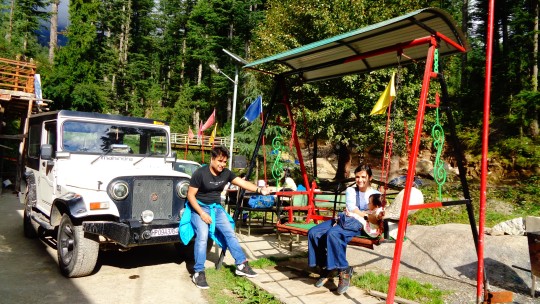
Shikari peak
Situated at an elevation of 3359 m, the Shikari Devi temple is located atop Sikhari Devi Peak, the highest peak of the Mandi district. It is believed that the temple has been existing since the time of Mahabharata. The temple is dedicated to Shikari Devi, the Goddess of hunters. In the archaic days, the hunters or shikaris of the region would worship the Goddess in the temple to seek blessings for a successful hunt. Hence, the temple got its name, temple is on a flat cemented square platform and the goddess is idolized in the form of a stone image. The most interesting fact about Shikari Devi Temple is that this temple does not have a roof as no one has ever been able to build a roof over the top of this temple. no snow is spotted inside the temple during winters when the entire region around this temple is covered up to several feet by snow.
Tracking tracks are banned in winters
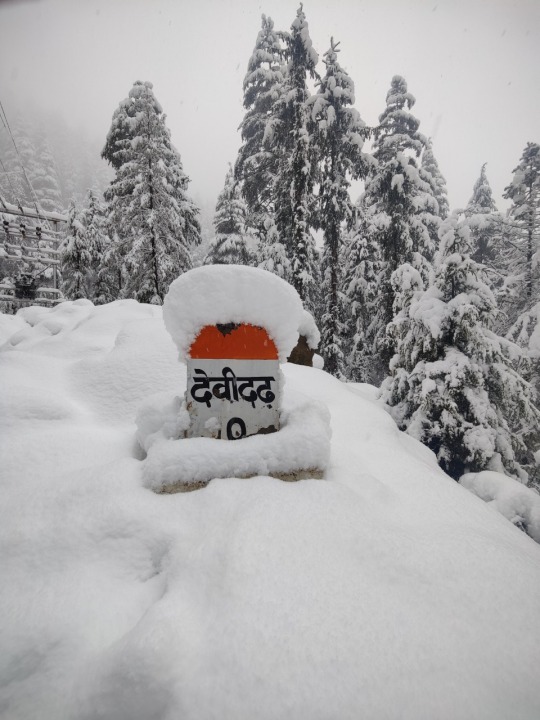
These tracks are banned in winter. In the summer season, trekking can be done with the help of tourist guide. GPS mapping of these tracking is also being done. So that tourists don't get lost. Never underestimate nature here, Drive carefully, minor negligence will dangerous for life.
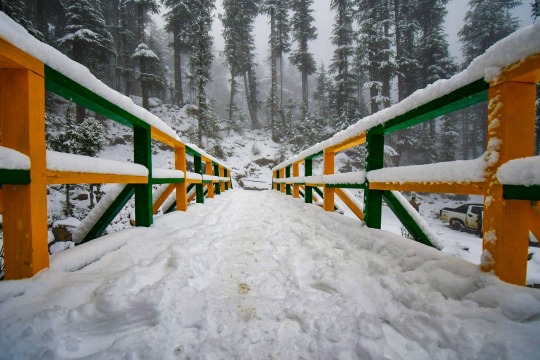
Devidarh park
Just Rs20:Take a ride of boat in middle of deodars
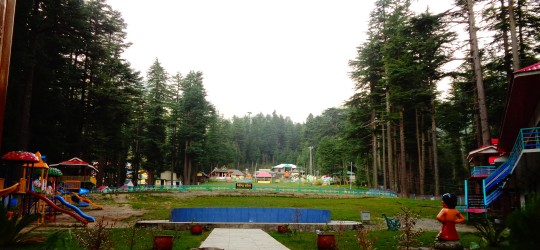
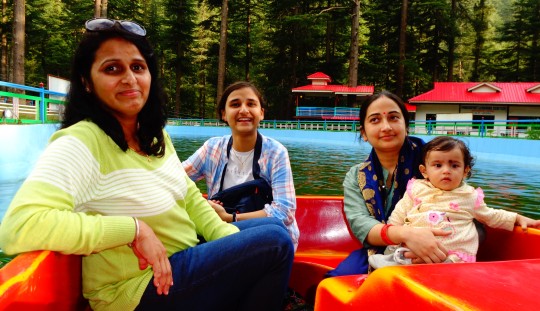
To entice the tourists, the park has been developed in the open ground among the deodars. As soon as you step on the entrance, there is an artificial lake after some distance. Tourists can enjoy boating for just twenty rupees per ride in the litigants that relax the soul. There is a tree house next to the lake.

The walking trail leads to swings made for children. Swings for children are the main attraction.
Accomadtion starts from 500

For accommodation, the tourism department has provided Gampling (luxury tents) and tents. Tourists can stay in the forest rest house at Devidarh. Home stay are also available. The rooms starts from jst Rs 500. According to District Deputy Commissioner Mandi Arindam Choudhary, the tourism department is going to add this tourist place to the Nai Manzil Nai Rahein scheme.
How to reach
ON BUS
The distance from Mandi to Devidarh is about 42 kms. A link road has been made for this tourist place beyond Chail Chowk on the Mandi-Janjehli road. This distance can be easily covered By bus. Buses are available from Sundernagar, Mandi, Chailchowk.
BY TRAIN
The nearest railway station from Devidarh is at Jogindernagar, 111 kms away. It is a short line railway station, which is connected to the main line at Pathankot.
Air connectivity
Nearest airport from Devidarh is at Kullu Bhuntar at a distance of 94 kms. Mandi can be easily reached by road.
Make family trip on summer
There are also popular places like Janjehli, Shikari Devi, Kamrunag on the way to Devigarh trek. The climate of Devidarh remains very cold throughout the year. There is heavy snowfall here. Summer season is appropriate time to come here. Take warm cloths, firstaid box, hunter shoes and confectionary items when you come here.
7800 ft : Mundsan Mata Temple Centre of Attraction

Located at an altitude of about 7800 feet above sea level, Devidaddh is the last village in the Jauni Valley. There is a temple of Mundsan Mata here. The view around the temple is also very beautiful. This temple attracts tourists towards it. Here tourists come from far and wide and come to the mother's temple and take blessings.
2 notes
·
View notes
Text
Kolkata to Manali Packages: A Traveler's Odyssey Through Eastern and Northern India

If dreaming of going from the cultural Kolkata to the serene Manali, Look no further. Embark further on a journey of a lifetime with our exclusive Kolkata to Manali trip package.
It is perfect if you are yearning for a thrilling tour amidst the majestic Himalayas. In this travel guide, we'll unveil the wonders of this scenic route. Meanwhile, we highlight the scenic regions and experiences that await you.
Discover Kolkata: The City of Joy
Your expedition commences in Kolkata, the vibrant capital of West Bengal. It is firstly famous for its rich cultural aspects and tasty cuisine. Begin your trip https://www.manalipackages.in/kolkata-to-manali-packages by immersing yourself in the city's ancient landmarks.
Few are for example the famous Victoria Memorial and the huge Howrah Bridge. Explore the narrow alleys of Kumortuli, where skilled artisans craft unique idols of deities. That further breathe life into the city's functions.
As you savor the flavors of Kolkata's street food, tantalize your taste buds. Go for the tasty dishes for example Kathi rolls and Rosogollas. Dive into the bustling markets of New Market and College Street. There, you can meanwhile indulge in a shopping spree. You can collect souvenirs and gems to remind about your journey.
Journey to the Hills: Kolkata to Kullu
Leaving behind the bustling streets of Kolkata, embark on a scenic road trip towards the pristine valleys of Kullu. Traverse through the picturesque landscapes of West Bengal and Himachal Pradesh, witnessing the gradual transition from urban chaos to tranquil countryside. Feel the cool mountain breeze as you ascend higher into the Himalayas, leaving behind the sweltering plains of Kolkata.
Meanwhile, make pit stops at quaint towns and villages along the route. There, you can talk with the locals, learning about their unique way of life. Marvel at the flowing waterfalls and verdant meadows that adorn the Himalayan foothills. That further offer a glimpse of nature's stunning beauty.
Embrace the Serenity of Manali
Reaching the town of Manali, prepare to be stunned by its unique beauty and serene ambiance. Nestled amidst snowy peaks and lush forests, Manali is a haven for nature and adventure seekers. Firstly, check into your cozy stay. There, you can unwind and revive after a long day of travel.
Spend your days exploring the various places that Manali has to offer. Visit the ancient Hadimba Temple, devoted to the goddess Hadimba Devi. Marvel at its minute wooden structure set against the backdrop of towering deodar trees. Take a stroll along the banks of the Beas River, soaking in the beauty of the ambiance.
Adventure Awaits: Thrilling Activities in Manali
For the thrill junkies, Manali offers a number of outdoor activities to satisfy your thrilling spirit. Embark further on a trekking tour to the stunning Rohtang Pass. There you can witness scenic views of the Himalayan landscape and frolic in the snow. Meanwhile, indulge in white water rafting on the Beas River. Go through turbulent rapids amidst the stunning vistas.
For those seeking solace amidst nature, opt for a quiet nature walk. That, you can take through the dense forests nearby Manali. There, you can spot unique wildlife and rare bird species. Further, embark on a soul stirring journey to the nearby town of Kullu. That is firstly famous for its vibrant culture and ancient handicrafts.
Culinary Delights and Cultural Experiences
No trip to Manali is complete without indulging in its delectable culinary offerings. Savor authentic Himachali cuisine, featuring savory delicacies like Siddu, Thenthuk, and Babru, prepared with locally sourced ingredients and traditional cooking techniques. Do not forget to sample the famous apple based delicacies, including apple pie and apple cider, a specialty of the region.
Immerse yourself in the vibrant culture of Manali. Take part in local festivals and cultural events. There, you can witness vivid dances and folk programs showing the rich culture of the Himalayan people. Meanwhile, engage with local artists and craftsmen. Above all, learn about their age old methods passed down through years.
Conclusion: A Journey to Remember
As your Kolkata to Manali tour draws to a close. So, you will find yourself reminding about the joyful experiences and moments. That, you have further created along the way. It starts from the bustling streets of Kolkata to the serene landscapes of Manali. In short, each place has left an indelible mark on your heart. That further beckons you to return again someday.
So don't wait, embark on this epic adventure. Explore the wonders of the Himalayas with our exclusive Kolkata Kullu Manali package price. Get ready to embark on a journey of discovery. There each twist and turn reveals a new marvel waiting to be seen. Your adventure awaits further for you.
0 notes
Text
Study Notes on Forest and Wildlife Resources for Class 10 Geography-NCERT
Introduction
Forest and wildlife resources are crucial components of our environment, contributing significantly to biodiversity, ecological balance, and the sustenance of various life forms. Understanding these resources is vital for the sustainable management of our planet's natural heritage. In this guide, we will explore the types, importance, threats, and conservation measures related to forest and wildlife resources class 10.

Forest Resources
Types of Forests
1. Tropical Evergreen Forests:
Found in regions with heavy rainfall.
Dense and multi-layered with a rich variety of species.
Major species: Mahogany, ebony, and rosewood.
Locations: Western Ghats, Andaman and Nicobar Islands, parts of northeastern India.
2. Tropical Deciduous Forests:
Also known as monsoon forests.
Trees shed their leaves during the dry season.
Major species: Teak, sal, sandalwood.
Locations: Central India, parts of northern and western India.
3. Temperate Forests:
Found in high altitude areas with moderate climate.
Include both evergreen and deciduous trees.
Major species: Oaks, pines, and deodars.
Locations: Himalayan region, Nilgiri Hills.
4. Montane Forests:
Located in mountainous regions.
Varying composition based on altitude and climate.
Include both temperate and alpine forests.
5. Mangrove Forests:
Found in coastal regions and estuaries.
Adapted to saline water conditions.
Major species: Rhizophora, Avicennia.
Locations: Sundarbans, Mahanadi Delta.
Importance of Forests
1. Ecological Balance:
Forests play a critical role in maintaining the balance of ecosystems.
They act as carbon sinks, reducing greenhouse gases.
2. Biodiversity:
Forests are home to a vast array of flora and fauna, contributing to biological diversity.
They provide habitat, food, and breeding grounds for numerous species.
3. Climate Regulation:
Forests influence local and global climates by regulating temperature and precipitation patterns.
They play a role in the water cycle through transpiration.
4. Soil Conservation:
Forests prevent soil erosion by stabilizing the soil with their root systems.
They enhance soil fertility through leaf litter and organic matter.
5. Economic Resources:
Forests provide timber, fuelwood, fodder, and non-timber forest products (NTFPs) like fruits, resins, and medicinal plants.
They support livelihoods of indigenous and local communities.
6. Recreational and Aesthetic Value:
Forests offer recreational opportunities such as hiking, bird watching, and eco-tourism.
They provide scenic beauty and cultural value.
Wildlife Resources
Types of Wildlife
1. Terrestrial Wildlife:
Includes animals living on land such as tigers, elephants, deer, and primates.
Found in diverse habitats like forests, grasslands, and deserts.
2. Aquatic Wildlife:
Includes species living in water bodies such as fish, amphibians, and marine mammals.
Found in freshwater ecosystems (rivers, lakes) and marine ecosystems (oceans, coral reefs).
3. Avian Wildlife:
Encompasses bird species ranging from migratory birds to endemic ones.
Found in various habitats including forests, wetlands, and urban areas.
Importance of Wildlife
1. Ecological Balance:
Wildlife maintains ecological balance through food chains and food webs.
Predators control the population of herbivores, preventing overgrazing.
2. Biodiversity:
Wildlife contributes to genetic diversity, which is vital for adaptive evolution.
Protects against the collapse of ecosystems by maintaining resilience.
3. Economic Value:
Wildlife tourism generates revenue and employment.
Provides raw materials for various industries such as pharmaceuticals and handicrafts.
4. Cultural and Aesthetic Value:
Wildlife holds cultural significance for many communities.
Enhances the aesthetic value of natural landscapes.
Threats to Forest and Wildlife Resources
1. Deforestation:
Caused by logging, agriculture, urbanization, and infrastructure development.
Leads to habitat loss, soil erosion, and climate change.
2. Poaching and Hunting:
Illegal hunting for fur, ivory, and other animal parts.
Threatens endangered species and disrupts ecological balance.
3. Pollution:
Industrial and agricultural pollution affects air, water, and soil quality.
Harms wildlife health and habitats.
4. Climate Change:
Alters habitats and affects the distribution and behavior of species.
Leads to the loss of biodiversity and ecosystem services.
5. Invasive Species:
Non-native species introduced intentionally or accidentally.
Compete with native species and disrupt ecosystems.
6. Forest Fires:
Natural and human-induced fires destroy large forest areas.
Affect biodiversity, soil fertility, and air quality.
Conservation of Forest and Wildlife Resources
1. Protected Areas:
Establishment of national parks, wildlife sanctuaries, and biosphere reserves.
Provide legal protection to habitats and species.
2. Afforestation and Reforestation:
Planting trees in deforested areas and degraded lands.
Enhances forest cover and restores ecosystems.
3. Wildlife Protection Laws:
Implementation of laws like the Wildlife Protection Act (1972) in India.
Prohibits hunting and trade of endangered species.
4. Community Participation:
Involving local communities in conservation efforts.
Promotes sustainable use of resources and traditional knowledge.
5. Eco-development Programs:
Development projects that balance ecological and economic needs.
Support alternative livelihoods to reduce dependency on forests.
6. Research and Monitoring:
Scientific research on species and ecosystems.
Monitoring changes and threats to implement effective conservation strategies.
7. Awareness and Education:
Public awareness campaigns on the importance of forests and wildlife.
Environmental education in schools to foster a conservation ethic.
Conclusion
The sustainable management of forest and wildlife resources is essential for maintaining ecological balance, supporting biodiversity, and ensuring the well-being of human communities. As students, it is crucial to understand the significance of these forest and wildlife resources class 10 notes, the threats they face, and the measures required for their conservation. By fostering awareness and taking active roles in conservation efforts, we can contribute to the preservation of our natural heritage for future generations.
0 notes